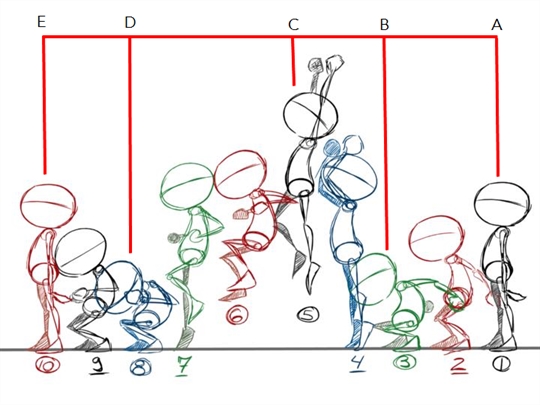- Modules
- Animation Principles
- Straight Ahead and Pose-to-Pose Principle
Straight Ahead and Pose-to-Pose Principle
T-PRIN-004-005
These are two different ways to animate an action. The straight-ahead technique means to animate your action from drawing 1 to the end in sequence order. The pose-to-pose technique is a bit more intricate as it means to draw the key poses first (often the beginning and end drawing of the action and some other key moment between. Once the key poses are done, the breakdown and inbetween drawings are added to fill the rest of the animation. Smoke, water and other fluid elements are often animated using the straight-ahead technique. Actions that require tight timing and structure are often animated with the pose-to-pose technique. This method helps maintain a solid structure and preserve the volume. Sometimes, when using the straight-ahead technique, it may be difficult to calculate where the action will end up and the final drawing may be out of proportion and not where it should be.

Keyframes are the significant poses in a character's action, such as the first and last positions in a jump.

In-betweens are all of the drawings between the keyframes; they move the action from one keyframe to another.
The more drawings there are between keyframes, the slower the action will appear. This is because more drawings means that there is more time to complete the same action.

In animation, space = time. The more space there is between drawings, the faster the action will appear to progress. And vice versa; the less space there is between drawings, the slower the action will appear. Basically, when two drawings are far apart, the time it takes to go between them appears shorter than the time taken to go between two drawings placed close together.
Therefore, remember the following:
Pose-to-pose animation is characterized by the process of first drawing your key poses at significant points in the action, refining the key drawings, and then doing the in-betweens. This process gives the creator more control and ensures the accuracy of the final result. This is how you worked when you created the pendulum animation. You started by creating your key poses!
Straight ahead animation is drawn from the first position to the last in a linear sequence. There is very little planning in this methodology, and where the character ends up and how it gets there can be a surprise for both the audience and the animator. While this approach is a lot more spontaneous and creative, it can create inaccurate results.
Next Topic
Follow Through Principle
Time Estimated 15 mins
Difficulty Level Beginner
Topics List
- Introduction to Animation Principles
- Squash and Stretch Principle
- Timing Principle
- Anticipation Principle
- Straight Ahead and Pose-to-Pose Principle
- Follow Through Principle
- Arcs of Rotation Principle
- Slow-in and Slow-out Principle
- Secondary Action Principle
- Exaggeration Principle
- Solidity Principle
- Activity 1: Experimenting with Space and Time
- Activity 2: Drawing a Pendulum
- Activity 3: Animating the Playground (Optional)
- Activity 4: Observation and Timing
- Activity 5: Drawing a Bouncing Basket Ball and Bowling Ball
- Activity 6: Animating a Bouncing Ball with a Tail